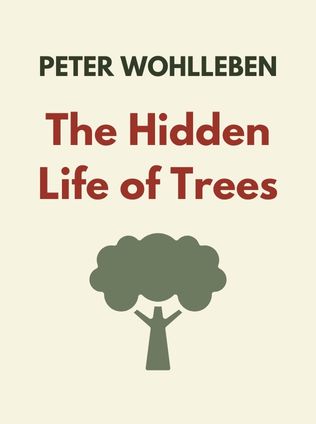
The Hidden Life of Trees
What They Feel, How They Communicate
By Peter Wohlleben
Published 05/2015
About the Author
Peter Wohlleben, a German forester and environmental activist, has captivated the world with his deep insights into the hidden lives of trees. With over two decades of experience as a civil servant in the state forestry administration, Wohlleben’s journey into the depths of forest ecosystems began with a desire to understand the intricate relationships that trees maintain within their environment. He eventually founded the Forest Academy to provide training in sustainable forest management, further cementing his role as a global advisor on forestry issues.
Wohlleben’s most renowned work, The Hidden Life of Trees, published in 2015, has been celebrated for its groundbreaking revelations on the complex lives of trees. His other significant works include The Heartbeat of Trees (2021) and The Power of Trees (2023). His contributions to environmental literature have earned him several prestigious awards, including the Heinz Sielmann Award and the Environmental Award from Environmental Action Germany. Wohlleben's influence extends beyond the written word, as his book was adapted into a documentary film in 2021, reaching an even broader audience.
Main Idea
The Hidden Life of Trees presents a compelling argument for rethinking our relationship with forests. Wohlleben invites us to see trees not just as passive entities but as complex, sentient beings capable of cooperation, communication, and even a form of intelligence. He argues that trees live in communities, where they share resources, communicate dangers, and work together to create a thriving ecosystem. Through this lens, Wohlleben challenges the traditional view of trees as mere resources to be harvested and instead presents them as vital, living beings deserving of our respect and protection.
Table of Contents
- The Complex Lives of Trees
- Trees as a Community
- Trees and Communication
- Trees as Sentient Beings
- The Importance of Trees to the Global Ecosystem
- Our Responsibility to Forests
- Conclusion
The Complex Lives of Trees
Wohlleben argues that throughout history, humans have perceived trees primarily as resources, reducing their existence to mere commodities. However, trees are far more complex and intelligent than we've previously thought. They are capable of cooperation, communication, and even sentience, often imperceptible to human observers. This shift in understanding has the potential to dramatically alter how we interact with and care for our forests.
Trees as a Community
One of the most fascinating aspects of Wohlleben’s work is his exploration of how trees in old-growth forests cooperate with one another. Unlike the competitive nature often attributed to natural ecosystems, Wohlleben highlights the communal life of trees, where they share nutrients, provide mutual protection, and create a stable environment conducive to the growth of their entire community.
For example, older trees in a forest provide shelter for younger ones, creating a canopy that offers protection from harsh weather conditions. As these younger trees grow, the older ones eventually die, making space for the next generation. This communal living space mitigates environmental stresses, forming microclimates that support their survival.
Wohlleben explains that this cooperation extends to nutrient sharing through a vast underground network of roots and beneficial fungi. These fungi work in tandem with the trees to extract and distribute essential nutrients, particularly sugars, from the soil. This process is akin to the way diverse organisms within the soil decompose organic matter, recycling nutrients to maintain a healthy and sustainable ecosystem.
This interconnectedness is not just a superficial phenomenon but goes deep into the very fabric of the forest. The roots of trees intertwine with each other, often fusing together over time to form an intricate web of support. This underground network is vital for the health of the entire forest, as it ensures that no tree is left to struggle alone. In times of drought, trees will share water resources through this network, ensuring the survival of the community as a whole.
Wohlleben also highlights the role of "mother trees," the oldest and largest trees in the forest, which act as central hubs in this network. These mother trees have extensive root systems that connect with a multitude of other trees, allowing them to distribute nutrients and resources where they are most needed. They play a crucial role in maintaining the balance of the forest, often sacrificing their own well-being to support younger or weaker trees.
Furthermore, the symbiotic relationship between trees and fungi, known as mycorrhiza, is a testament to the complexity of these ecosystems. Fungi are unable to photosynthesize and rely on trees for the sugars they need to survive. In return, fungi extend the reach of the tree's roots, allowing them to access water and nutrients that would otherwise be out of reach. This mutually beneficial relationship is essential for the health of the forest, as it enhances the trees' ability to survive in challenging conditions.
Tree Cooperation
- Older trees provide shade and protection to younger saplings.
- Underground networks of fungi facilitate the exchange of nutrients among trees.
- Trees create microclimates that moderate temperature and weather extremes.
- Mother trees act as hubs, distributing resources to younger or weaker trees.
Wohlleben's discussion of tree cooperation is supported by the research of Canadian ecologist Suzanne Simard. Simard’s findings reveal that certain "mother trees" act as central hubs in the nutrient distribution network. These older trees exhibit preferential behavior toward their own offspring, particularly in times of environmental stress. This maternal care, so to speak, emphasizes the sophisticated social systems that trees maintain, which transcend mere survival instincts and reflect a deeper, communal bond.
“These mother trees increase the quantity of nutrients sent to their own offspring.” — Peter Wohlleben
Trees and Communication
Wohlleben further explores how trees communicate with each other, employing various methods such as chemical signals, olfactory cues, and possibly even sounds. This communication is crucial for their survival and the maintenance of the forest ecosystem.
Trees utilize an underground network of fungi, often referred to as the "wood wide web," to send chemical signals to warn each other of potential dangers. For instance, if one tree is attacked by insects, it can send out a chemical alert through this network, allowing neighboring trees to prepare their defenses.
Sign up for FREE and get access to 1,400+ books summaries.
You May Also Like
Factfulness
Ten Reasons We're Wrong About the World – and Why Things Are Better Than You Think
By Hans RoslingBraiding Sweetgrass
Indigenous Wisdom, Scientific Knowledge and the Teachings of Plants
By Robin Wall Kimmerer



















